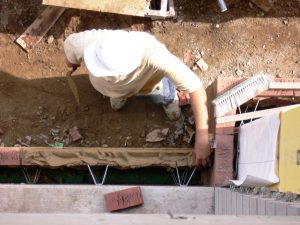The density of building mortar refers to the mass density of a certain proportion of uniformly mixed and stirred cementitious materials, sand and water. As for the component materials of mortar, their respective density is as follows: the apparent density of lime putty (1350kg/m³) > the bulk density of cement (1280kg/m³) > density of water (1000kg/m³). The apparent density of cement is 3.1g / cm. By theoretical analysis, with the increase of mortar strength, for cement mortar, the amount of cement used will increase and its density will also increase. For the composite mortar, the amount of cementitious materials and admixtures used for 1m³ of mortar mixture is certain, 300-350kg; while the amount of water used will increase with the increase of mortar strength and cement amount, which, therefore, tend to follow similar patterns of cement mortar. When the strength grade of mortar is the same and the amount of cement used is also basically the same, due to the addition of lime putty of greater density into the composite mortar, the density of composite mortar is slightly less than that of cement mortar of the same strength grade. Experimental data indicate that the practically measured value and the theoretically calculated value of mortar density are very close, and that the regularity and theoretic analysis are identical.
The density of building mortar is closely related to its component materials and directly affects the strength of mortar. Whether cement mortar or composite mortar, the density will increase with the increase of mortar strength.
In order to improve the workability of mortar, water-retaining and thickening materials are often added into the mortar. Water-retaining and thickening materials are divided into inorganic and organic, or air-entraining and non-air-entraining types. When non-air-entraining water-retaining and thickening materials are added into the mortar, generally there will be little effect on the density of mortar; while air-entraining water-retaining and thickening materials are added(Hydroxypropyl Methyl Cellulose), there will be a greater impact on the density and strength of mortar. The larger the added amount is, the smaller the density will be. And meanwhile the compressive strength will also get substantially decreased. For instance, when the air content of mortar is 20%, the compressive strength will decrease by about 25%. Therefore, the control of the density of building mortar can play a certain role both in ensuring its various properties such as the strength and in limiting the amount of raw materials used. The density of cement mortar is required to be no less than 1900kg/m³, and that of cement composite mortar should be no less than 1800kg/m³.

